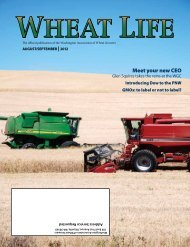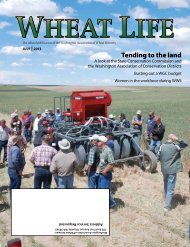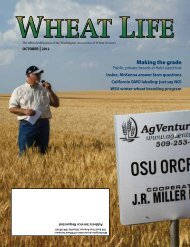Download - Wheat Life
Download - Wheat Life
Download - Wheat Life
You also want an ePaper? Increase the reach of your titles
YUMPU automatically turns print PDFs into web optimized ePapers that Google loves.
WGC REPORTS WL<br />
Brett Blankenship (left), chairman of the domestic policy<br />
committee of the National Association of <strong>Wheat</strong> Growers<br />
and a farmer from Washtucna, and Wayne Hurst, an Idaho<br />
farmer who is president of NAWG, were all fingers as they<br />
communicated with the national office about the latest<br />
farm bill developments at the recent Tri-State Convention.<br />
Nicole Berg never knows when the camera<br />
on her smart phone will be called into action.<br />
Sometimes it is used to photograph a rainbow.<br />
Other times, it’s used to document a breakdown<br />
like this one.<br />
younger generation of farmers who have embraced smart phones as<br />
the high-powered pocket computers they are. Working a farm that<br />
is both irrigated and dryland, the ability to control and monitor irrigation<br />
pivots by phone has revolutionized the way they operate.<br />
“Back in the day, we used to need an individual—or two or<br />
three—on the farm 24 hours a day to physically go to the pump<br />
and push a button to start the water and troubleshoot. Now, we can<br />
turn on and off our pumps and pivots by our smart phones, we can<br />
see on a map which circles are running and which ones aren’t and<br />
if there are any in trouble,” she said.<br />
Berg said the ability to have control in the palm of their hands<br />
has saved the operation thousands of dollars and countless<br />
headaches.<br />
“It’s not just the extra help we don’t need to hire, it’s the extra<br />
pickup we can do without. And it’s so fast. If something goes<br />
wrong, there’s a phone alert, and we can transfer water to another<br />
pivot or shut down immediately so we don’t have lines blow up<br />
that will hurt the rest of the system,” she said.<br />
At 57, Steve Hair, who farms near Walla Walla, is close to the<br />
average age of the Eastern Washington wheat farmer demographic.<br />
That, however, is about all that’s typical about him. Hair wowed<br />
a team of Natural Resource Conservation Service personnel who<br />
came to his farm by using a Global Position System application on<br />
his phone to show them moving across the topography. The screen<br />
also highlighted the individual tracks he was thinking about put-<br />
WASHINGTON GRAIN COMMISSION<br />
WHEAT LIFE JANUARY 2012 51










